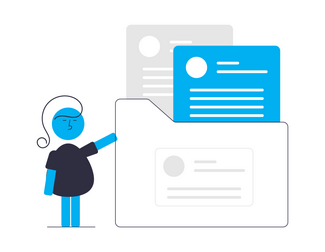
Table of Contents
- Physical filing in California Superior Courts
- Three ways to file physically in California courts
- #1: In-person physical filing
- #2: Physical court filing by mail
- #3: Physical filing by fax
- Common mistakes with physical court filings
- Improve your court acceptance rate: Let Rapid Legal physically file for you

Physical filing in California Superior Courts
It’s a fact: The Golden State’s Judicial Court system is the biggest in the nation and one of the busiest in the world.
And about 26% of the 636,142 court filings in California in 2021-2022 were physical filings, so there’s a good chance that sooner or later you’ll need to do a physical filing for your firm.
Despite electronic filing making strong inroads throughout the California judicial system, physical filing is still used in 28 of 58 county superior courts as of Q3 2022. In the table below, each county that allows physical filing in one form or another is linked to the respective court’s website.
Table 1.
| California Superior Courts Using Physical Filing Methods | ||
|---|---|---|
| Alpine | Madera | San Joaquin |
| Amador | Marin | Shasta |
| Colusa | Mariposa | Sierra |
| Del Norte | Modoc | Siskiyou |
| El Dorado | Mono | Solano |
| Glenn | Nevada County | Trinity |
| Humboldt | Plumas | Tuolumne |
| Inyo | Sacramento | Ventura |
| Lake | San Benito | |
| Lassen | San Bernardino | |

Three ways to file physically in California courts
The numbers make it clear that physical court filing is going to be with us for some time, even though it is a slower process than filing electronically. To keep your physical court filings from slowing down even more, it’s important they get done right the first time.
This section of the guide helps you do that, beginning by breaking down the three ways court documents may be physically filed in California:
- In-person (at the filing counter of the court’s clerk or at a drop box).
- By mail.
- By fax.
The requirements for physical filings can vary from court to court and depending on the type of matter or proceeding. Filers need to understand each court’s particular filing criteria.
So, before you enter the first keystroke for your filing, make sure you know:
- Type of physical filing permitted by the court.
- Forms required.
- How to correctly fill out a form.
- Filing deadlines.
- Formatting, binding and information requirements of the document and exhibits.
- Number of copies needed.
- Filing fees and how to pay them.
- Return document requirements.

#1. In-person physical filing
At the counter of the court clerk
The court clerk window (or counter) is the hub of physical filing. In person, this is where documents are submitted, and the filing fee is paid.
Two important things happen at the court clerk’s window during physical filing:
- The court clerk inspects the document to ensure it complies with the court’s rules and verifies the information is correct.
- If the information is correct the clerk stamps the document and the copies as received. For the filer’s records and evidence that a filing took place on the said date, the court clerk should then provide what is called a ‘conformed copy’ which is an exact copy of a document filed with a clerk with an official stamp.
Knowing immediately that a document has been accepted by the court provides the filer peace of mind, especially when a tight statutory deadline must be met.
The tradeoff, however, is that peace of mind most likely will be earned by someone spending long periods of time waiting in line.
|
Something cool about physical filing The physical court document filing process is slower and more cumbersome than filing electronically (eFiling); that’s not news. But what is newsworthy is this one distinct benefit that in-person court filing offers: The filer knows immediately whether the document was accepted or rejected by the court clerk. This benefit doesn’t get a lot of applause, but courts’ online technologies haven’t been able to beat it yet. |

At a court drop-box
It’s not uncommon for courthouses to experience reduced hours or for staff to be furloughed due to judicial budget cuts.
Therefore, drop boxes can be offered by courts to make physical filing still available. Drop boxes allow documents to be deposited for filing outside of a court’s normal operating hours or at other times of the day when a court is not accepting counter filings.
California Rule 2.210 states how drop boxes are to be used when it is an option:
(a) Use of drop box
Whenever a clerk’s office filing counter is closed at any time between 8:30 a.m. and 4:00 p.m. on a court day, the court must provide a drop box for depositing documents to be filed with the clerk. A court may provide a drop box during other times.
(b) Documents deemed filed on day of deposit
Any document deposited in a court’s drop box up to and including 4:00 p.m. on a court day is deemed to have been deposited for filing on that day. A court may provide for same-day filing of a document deposited in its drop box after 4:00 p.m. on a court day. If so, the court must give notice of the deadline for same-day filing of a document deposited in its drop box.
(c) Documents deemed filed on next court day
Any document deposited in a court’s drop box is deemed to have been deposited for filing on the next court day if:
(1) It is deposited on a court day after 4:00 p.m. or after the deadline for same-day filing if a court provides for a later time; or
(2) It is deposited on a judicial holiday.
(Subd (c) amended effective January 1, 2007.)
(d) Date and time documents deposited
A court must have a means of determining whether a document was deposited in the drop box by 4:00 p.m., or after the deadline for same day filing if a court provides for a later time, on a court day.
Rule 2.210 amended and renumbered effective January 1, 2007; adopted as rule 201.6 effective January 1, 2005

Drop box requirements will be different. Count on it.
California courts are characterized by a patchwork of court requirements that vary from one jurisdiction to the next. What you know about one California court may not apply to courts across the county line, including requirements for drop box filings.
Therefore, filers should be sure to know the differences about the following before they use a drop box:
- Date stamping procedures
- The kinds of documents can/cannot be filed via drop box
- Use of pouches or folders for depositing documents
- Inclusion of filing information in the pouch or folder
- Enclosing correct filing fee
- Providing return envelopes for conformed copies for pick up by a messenger
- Enclosing self-addressed, stamped envelope for copies to be returned to the filer by mail.
Are they safe?
Drop boxes have been around for a long time. For example, the U.S. Postal Service’s proto drop box (known as a letter box) first appeared in 1858. The kangaroo, nature’s original drop box, appeared even earlier.
The low-tech nature of the drop box may lead you to question whether it is secure and safe to use.
The answer is, “Yes.”
Drop boxes are considered a safe method for physical filings and documents are usually processed the next day.
Note: Some California courts are experiencing delays with drop box filings and have long turnaround times for certain kinds of filings.
For example, if you are currently filing into San Bernardino County Court or Sacramento County Court, Table 2 notes the delays in turnaround times you may anticipate for drop box filings:
Table 2.
| San Bernadino County Drop Box | |
|---|---|
| Type of Filing | Turnaround time |
| Case Initiation | 5 Weeks Behind |
| Answer | 2 Weeks Behind |
| Sacramento County Drop Box | |
|---|---|
| Type of Filing | Turnaround time |
| Case Initiation | 4-6 Weeks Behind |
| Other Documents | Time Varies |
Also noteworthy: San Bernardino County Court and Sacramento County Court require mandatory drop box filings for civil filings, and only Sacramento Family Court currently allows counter filings. However, there may be up to a 3-hour wait in line to do a counter filing in Sacramento Family Court.

#2: Physical court filing by mail
In most cases, documents can be filed by mail in any court that accepts physical document filings. It is important to keep in mind that filing by mail may slow down the process and should be avoided if your filing has tight deadlines.
Filing by mail is not as immediate or safe as filing in person at a counter/window, where you know if your filing is accepted and have your documents stamped on site.
Moreover, filing by mail adds the risk of your package becoming lost or delayed in the mail.
To find out what a court requires to file papers by mail, call the court clerk and ask about:
- The number of copies that need to be included with your original documents.
- The amount of the filing fee and the payment methods the court accepts.
- The court’s mailing address.
- How to provide for the return of your filed documents (i.e., If you need to include a self-addressed envelope with enough postage so the clerk can return the filed documents back to you).
Need Physical Court Filing AND eFiling?
Rapid Legal’s technology and document specialists can help you with all your civil court filings in California.
Contact an account executive now: (909) 664-9565
#3: Physical filing by fax
The fax lives on in the California court system. Some California courts allow filing by faxing documents to the court and provide a dedicated fax number. As with other kinds of physical court filings, there are different requirements and considerations for fax filings. These include:
- The use of fax cover sheet.
- Marking documents “By Fax”.
- Restrictions on the number of pages.
- Filing fees (which include court filing fee, an additional fee per page and a fax filing fee).
- Inclusion of instructions for payment.
- How receipt of the documents will be confirmed by the court.
It is important to confirm that a court accepts fax filing and to contact the clerk of the court, if needed, to understand the requirements and obtain the correct fax number.
Common mistakes with physical filings
Even some of the most experienced legal professionals can make missteps with physical filings. Some of the most common errors are:
- Missing pages
- Missing required local court documents
- Incorrect case number
- Missing signature
- Document not legible
- Court location is different on documents than where the filer is trying to file
If you’re wondering how to stay on top of it all, the following resources can help bring you up to date about specific state and county rules:
- California Courts
- Local Rules
- Judicial Council Forms
- Help Filling out Judicial Council Forms
- Rapid Legal’s Resource Library

Improve your court filing acceptance rate: Let Rapid Legal physically file for you
Don’t have time to manage and track your physical court filings? Rapid Legal can take care of it for you in one of two ways.
|
Log on to Rapid Legal portal, upload your documents and place the order yourself. Rapid Legal will then arrange to have your documents filed at the court and provide you with confirmation and court-stamped documents. |
Use our Concierge Service and Rapid Legal will handle your physical court filing from start to finish. Our experts review your documents to check that they are correctly formatted and assembled and details such as signatures, parties, case numbers, etc., are included in the documents as needed. Rapid Legal arranges to have your documents filed at the court and provides you with confirmation and court-stamped documents. |
Rapid Legal can file physically into all California Courts that require physical filing.
Our technology makes your physical filing fast and easy, and the deep experience our court filing experts have with the California courts means they understand the variations in physical filing requirements across the state.
Turn to an experienced provider who understands the local court rules, can make your filings more efficient, and free up valuable firm resources.

Ready to find out more?
Book a demo or schedule a call with a team member. Get a close-up view of the Rapid Legal portal and how we can help with your physical filing needs and more.
Get Started Today
Spend more time on billable client hours and less time tracking down conformed copies and proofs of service.

